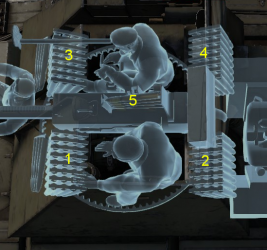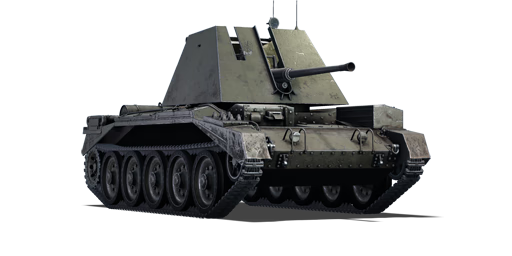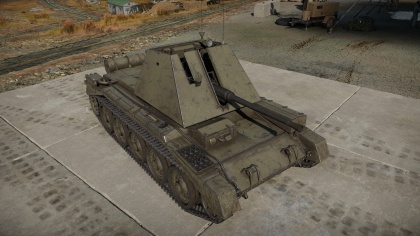Crusader AA Mk I
Contents
| This page is about the British SPAA Crusader AA Mk I. For other uses, see Crusader (Family). |
Description
The Crusader AA Mk I is a rank II British self-propelled anti-aircraft gun
with a battle rating of 3.0 (AB/RB/SB). It was released along with the entire British tree line in Update 1.55 "Royal Armour". Compared to the Mk.II variant, the Mk.I features a single 40 mm Bofors auto-cannon as its main armament. While it means a reduced rate of fire compared to the faster firing 20 mm Oerlikon auto-cannons, the 40 mm can cause devastating damage if it hits an aircraft.
In comparison to its predecessor and other 40 mm contemporaries like the American M19, the Crusader AA Mk.I unfortunately has some disadvantages. The single 40 mm cannon means that it cannot fire as fast as the 20 mm auto-cannons on the predecessor or have the fire density of the dual-cannons on the M19. Thus, accuracy is important to conserve what little ammo the SPAA can hold and to make sure that airplane gets hit.
The Crusader AA Mk.I is meant to be a SPAA, meaning it must stay away from the front lines or else it will easily be destroyed by the enemy. Instead, stay at least a good distance from the fighting and stay in cover, hopefully in an area where the gun has full 360° view of the whole sky to knock out any airplane attempting to strafe your allies.
General info
Survivability and armour
Armour type:
- Rolled homogeneous armour
| Armour | Front | Sides | Rear | Roof |
|---|---|---|---|---|
| Hull | 20 mm (33°) Front plate 9 mm (85°) Front glacis 20 mm (27°, 61°) Joint plate 20 mm (65°) Lower glacis 18 mm (1°) Driver's Port |
14 + 14 mm | 14 mm (14°), 12 mm (51°) Rear plate 14 mm (44-46°) Engine grille |
7 mm |
| Turret | 30 mm (36°) | 12 mm (14-15°) | 12 mm (19°) | N/A |
Notes:
- Suspension wheels and tracks are 15 mm thick.
Mobility
| Game Mode | Max Speed (km/h) | Weight (tons) | Engine power (horsepower) | Power-to-weight ratio (hp/ton) | |||
|---|---|---|---|---|---|---|---|
| Forward | Reverse | Stock | Upgraded | Stock | Upgraded | ||
| Arcade | 48 | 8 | 19.3 | 483 | 649 | 25.03 | 33.63 |
| Realistic | 44 | 7 | 301 | 340 | 15.6 | 17.62 | |
Armaments
| 40 mm Bofors | |||||
|---|---|---|---|---|---|
| Capacity (Belt capacity each) | Fire rate (shots/minute) |
Vertical guidance |
Horizontal guidance |
Stabilizer | |
| 160 (8) | 120 | -6°/+70° | ±180° | N/A | |
| Turret rotation speed (°/s) | |||||
| Mode | Stock | Upgraded | Prior + Full crew | Prior + Expert qualif. | Prior + Ace qualif. |
| Arcade | 23.8 | 32.9 | 40.0 | 44.2 | 47.0 |
| Realistic | 23.8 | 28.0 | 34.0 | 37.6 | 40.0 |
| Reloading rate (seconds) | |||||
| Stock | Prior + Full crew | Prior + Expert qualif. | Prior + Ace qualif. | ||
| 0.65 | 0.58 | 0.53 | 0.50 | ||
Ammunition
| Penetration statistics | |||||||
|---|---|---|---|---|---|---|---|
| Ammunition | Type of warhead |
Penetration in mm @ 90° | |||||
| 10m | 100m | 500m | 1000m | 1500m | 2000m | ||
| Mk.II | HEFI-T* | 3 | 3 | 3 | 3 | 3 | 3 |
| M81A1 | AP-T | 76 | 74 | 62 | 45 | 33 | 24 |
| Shell details | ||||||||||
|---|---|---|---|---|---|---|---|---|---|---|
| Ammunition | Type of warhead |
Velocity in m/s |
Projectile Mass in kg |
Fuse delay
in m: |
Fuse sensitivity
in mm: |
Explosive Mass in g (TNT equivalent): |
Normalization At 30° from horizontal: |
Ricochet: | ||
| 0% | 50% | 100% | ||||||||
| Mk.II | HEFI-T* | 874 | 0.86 | 0.2 | 0.1 | 63 | +0° | 79° | 80° | 81° |
| M81A1 | AP-T | 874 | 0.88 | N/A | N/A | N/A | -1° | 47° | 60° | 65° |
Belt types
| Belts | Shell composition | Combat usage |
| Default | AP-T / HEFI-T* | These work fine, a hit on an aircraft means certain death for it and still is able to hurt ground vehicles, especially if it is side into the side of a enemy tank. These seem like a good I don't know what i will run into belt. |
| Mk.II | HEFI-T* | These mean certain death for aircraft, what should be used for AA work. |
| M81A1 | AP-T | These are the worst belts against airplanes. however, they are able to hurt ground vehicles especially if it is side into the side of a enemy tank. If you plan on killing tanks load this and flank, since side shots are almost a necessity. |
Ammo racks

| Full ammo |
1st rack empty |
2nd rack empty |
3rd rack empty |
4th rack empty |
5th rack empty |
Visual discrepancy |
|---|---|---|---|---|---|---|
| 20 | 17 (+3) | 13 (+7) | 9 (+11) | 5 (+15) | 1 (+19) | no |
Usage in the battles
Despite being an SPAA vehicle, the Crusader struggles in an AA role. The gun is slow firing and fires at quite a low velocity, meaning that you will struggle to target fast moving enemy aircraft. Granted, a single hit will often spell doom for an enemy aircraft. Therefore, it is important to hide and wait for an opportune moment to open fire on an enemy aircraft. A low flying aircraft within 1km, flying at low speed, should be easier to hit. However, higher ranked and faster planes will can be a much harder target to his with the slow turret traverse for tracking and the slow fire rate of the gun.
The Crusader AA Mk.I can also serve in an anti tank role. With armour piercing rounds, the Crusader performs better than most SPAA in this role. With 76 mm of penetration, you can penetrate the frontal armour of light and some medium tanks and the side or rear armour of some heavy tanks. Poor post penetration damage means that you will need to target various sections of an enemy tank in order to destroy it. Some tanks will be almost invulnerable to your rounds, and while tanks KV-1 ZiS-5 can be dealt at point-blank range on the side or rear, there are many other heavy tanks that the 40 mm cannon will not penetrate.
Pros and cons
Pros:
- Fast speed of the Crusader light tank
- 40 mm Bofors auto-cannon can heavily damage aircraft if the Mk.II shell contacts
- Tall turret armour makes aircraft require to be a near vertical angle to hit the crew inside with machine guns
- Though thin, the turret armour is enough to protect the Crusader from anything up to 20 mm cannons on German aircraft
- Offers more protection to the gunnery crew than its German competitors
- AP shells have enough power to penetrate some tank armour, like the Panther's sides
Cons:
- Very little armour, especially the AA turret
- Cannon slot in front turret armour allows machine gun bullets to go through and injure/kill the crew
- Against attacker and bombers, 40 mm cannon is not a one-hit kill and repeated contact is necessary
- Exposed top leave crew vulnerable
- Slow firing gun, slow muzzle velocity, limited ammo
- Will be serving as a primary British SPAA until the Falcon, leading to having to track and fire against some of the fastest piston engine aircraft in the game and early jets, which are very difficult targets for the gun
History
Development
In 1938, the General Staff of the British Army requested for a cruiser tank that was lighter and more affordable than the heavier A16 cruiser design developed by Nuffield Mechanizations & Aero. One of these designs was the designation Tank, Cruiser Mk.V based off the A13 cruiser tanks, named the "Covenanter", and Nuffield was invited to become part of its development team, but they refused due to interest in developing their own cruiser tank. Their tank was designated the Tank, Cruiser Mk.VI Crusader and fell under the General Staff specification of A15. The Crusader was a parallel design to the Covenanter, but was ready six weeks earlier than the Covenanter despite starting at a later time. The Crusader was adopted into service with the British Army in 1941 and the 5,300 units were manufactured between 1940 to 1943.
Design
The Crusader features a new design that differs from its cruiser tank predecessors. The Christie suspension system on the Crusader had five road wheels for it instead of the usual four, which improves weight distribution of the increased 20 ton weight of the Crusader compared to the 14 tons of the A13 cruisers. The engine, steering system, and cooling system on the Crusader was different as well, but the Covenanter and Crusader use the same main turret. The polygonal shape of the turret gives the crew inside more room for the turret ring diameter.
The Crusader Mk.I and Mk.II were equipped with the 2-pounder, which was aimed by the gunner inside with a padded shaft that allows them to elevate the gun by simply adjusting his own height. Later in the war where an up-gun of the tank armament was necessary and newer tanks such as the Cromwell was delayed, the Crusader was upgraded into the Crusader Mk III variant with a 6-pounder instead, which restricted turret space, requiring the turret crew to be reduced from three to two. These saw first action the Second Battle of El Alamein in October 1942.
Combat usage
The Crusader first saw action at North Africa, right after the British had been pushed back to the Egyptian border by Axis forces. The Crusaders were part of the huge shipment in the Malta Convoys to reequip the British forces there. Enough Crusaders arrive that the entire 6th Royal Tank Regiment was refitted with them, which joined up with the 2nd Royal Tank Regiment to form the 7th Armoured Brigade "Desert Rats". The brigade's first action was in Operation Battleaxe, though it was delayed due to adapting the tanks for the desert environment. The operation, which called for the relieve of the siege of Tobruk in June, was initiated in June to which 11 Crusader tanks were lost to anti-tank guns, plus many more to mechanical faults. While more Crusader tanks came in to reinforce the cruiser tank forces, there were never enough to supply the continuously expanding armoured units as 7th Brigade was combine with the 7th Hussars, the 2nd Armoured Brigade was added to the 7th Armoured Division, and the 8th Hussars was combined with the 4th Armoured Brigade. Overall, the Crusaders proved effective in the North African Campaign, the Crusader was faster than any tanks on the opposing side and the 2-pounder was lethal to the Panzer III, but the tank suffered from its thin armour, mechanical problems in the desert, and the growing deficiency of the 2-pounder, which didn't have enough range to destroy farther tanks. The Crusader design also caused the ammo racks on the tank to easily ignite due to unprotected racks and shot traps on the turret design. Anti-tank guns continue to be the main reason the Crusader units suffer losses, rather than to enemy tanks.
By the end of 1941, only the 2nd Armoured Brigade retained the Crusaders, the rest of the other tank units were being refitted with better tanks, such as the M3 Grant medium tank from the American Lend-Lease. Crusader units were also refitted with the more powerful Crusader Mk.III with the 6-pounder, which improved the Crusader's ability to destroy the gradually stronger German tanks. After General Bernard Montgomery took command of the British Army in 1942, more British tank units were reequipped with the Grant and M4 Sherman tanks while the Crusaders were relegated from the front-lines to "light squadrons" meant to flank the enemy and attacked at its exposed sides. When the British 1st Army engaged the Axis at Tunisia, some tank regiments still use Crusaders mixed in with Valentine tanks. These units in the 26th Armoured Brigade, code named "Blade Force", worked alongside the 78th Infantry Division as an independent armoured column. During Tunisia, the 1st Army was already converting the tank regiments into Shermans, but the 8th Army continued to use the Crusaders for much longer, which would see use at the Battle of Wadi Akarit and Mareth Line.
After the North African Campaign, the Crusaders no longer saw any use in the front-lines and were used in other roles such as gun tractors with 17-pounders or anti-aircraft mounts such as the Crusader AA Mk.I and Mk.II Some Crusader tanks equipped the tank regiments that stayed back at the British Homelands such as the 11th Armoured Division.
The AA Tank Mk. 1 was issued to artillery light anti-aircraft regiments starting with the landing in Normandy, but the Mark I's were withdrawn from service soon after D-Day due to the Allied air supremacy and lack of Luftwaffe targets meaning significantly fewer anti-aircraft weapons ended up being required.
Survivors
About 21 Crusaders still exist intact in various parts of the world. The most notable places with the Crusaders are South Africa with 8 known survivors, a running Crusader Mk III at Bovington Tank Museum at England, and an anti-aircraft version at Musée des Blindés in France.
Media
An excellent addition to the article will be video guides, as well as screenshots from the game and photos.
Read also
Sources
Paste links to sources and external resources, such as:
- topic on the official game forum;
- other literature.
| Britain anti-aircraft vehicles | |
|---|---|
| Crusader AA | Crusader AA Mk I · Crusader AA Mk II |
| Wheeled | Staghound AA · AEC AA |
| Radar SPAAG | Chieftain Marksman |
| Missile SPAA | Stormer AD · Stormer HVM |
| Other | Light AA Mk I · Falcon |
| Canada | Skink · ADATS (M113) |
| South Africa | Ystervark · Bosvark · ZA-35 |





